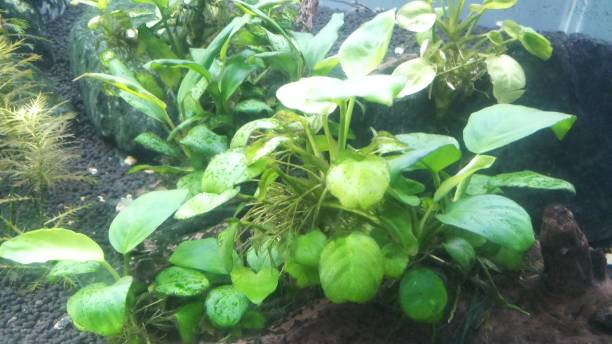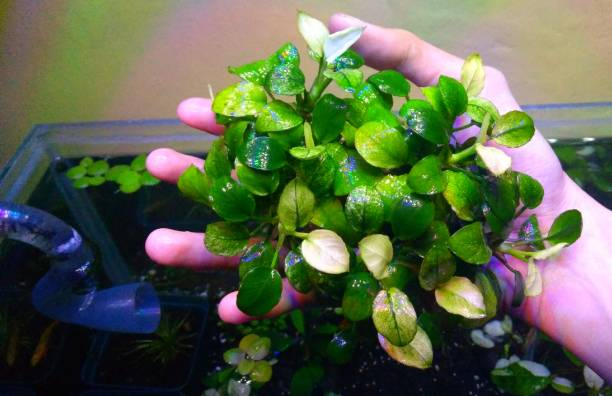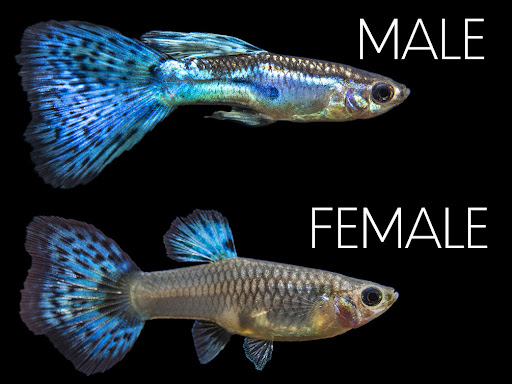Enhance your aquatic biodiversity with the Grass Guppy fish. This guide includes all care requirements for preserving its beauty and health.

The Graceful Grass Guppy Aquarium Fish
Are you a green thumb looking for a greenery-themed fish to add to your tank? Let me introduce you to the nature-inspired grass guppy, a unique variant of the South American small fish that’s taking over as the number one ornamental species in America.
This freshwater foliage fish has an interesting physical appearance that will warm your nature-loving heart. Its aquarium plant mimicry makes the Grass guppy look like an extension of your tank’s floral and plant decor.
If you’re excited about seeing how to highlight these nature-inspired features, then this guide is for you. Let’s start at the beginning.
Origins and Breeding Development of Grass Guppies
The development of Grass Guppies is an interesting story because they’re not the typical variant born in the wild. Instead, this species is a result of Guppy breeding advancements through genetic isolation and other selective breeding techniques.
Naturally, the grass variant is a lineage of green guppies native to Trinidad and Tobago in the South American waters. Because of their unique finnage and coloration, breeders in the late 19th century worked on pattern refinement in guppies to further highlight this specific look.
They succeeded in their quest and created the now beloved Grass Guppies. Here’s a closer look at their physical characteristics.
Distinctive Physical Characteristics of Grass Guppies

You can best appreciate the Grass Guppy’s physical characteristics by examining its features separately and as a whole.
Bold Coloration
This species has a botanical guppy appearance in that its coloration takes inspiration from natural aquatic plants. You’d mostly see the Grass Guppy in shades of green, yellow, orange, and blue along with having a variety of patterns from stripes to spots and iridescent scales.
Exquisite Fin Structure
The Grass Guppy fin elegance is a combination of its structure and coloration. Although it also has a fan-shaped tailfin like other ornamental and wild guppies, the Grass species has a unique split structure at its tips. Its tailfin looks like grass splinters or strains, hence its name. Foliage-Inspired Fish Traits.

Because of its nature-inspired guppy design, this species camouflages easily and feels at home inside aquariums with lots of plants as decor.
The entirety of the Grass Guppy’s physical looks, from its textured fish patterns to its unique stainless glass like fins on its 1 – 2 inch long body, makes this species a beautiful addition to any aquarium.
Keep reading to learn how to care for this fish and protect its physical appearance using specialized care guidelines.
Essential Care Guidelines for Grass Guppies
These specialized Grass Guppy care essentials focus on maintaining guppy vibrance through an optimized environment, and that starts with getting the water conditions right.
Ideal Tank Setup
Because Grass Guppies are small fish that love to move in groups, you can fit 5 – 6 in a 10-gallon rectangular tank. But I recommend getting a larger tank if you have much decor so you don’t cramp their space and stress your pets.
Water Parameters
Set the condition in your aquarium with tailored water parameters based on the Trinidad and Tobago freshwater rivers. Keep a pH level of 6.8 – 7.8, which is slightly neutral to slightly alkaline, and maintain a cool temperature of 74 – 82℉.
Also, ensure the hardness is soft to moderately hard by not exceeding 5 – 20 dGH.
Keeping the Water Clean
Once you set the ideal water parameters, you must work hard to keep it clean. A good start is to get a good filtration system that can remove dirt and leftover food while maintaining calm waters.
The next step is to change 25 – 30% of the water weekly if you want to prevent bacteria and fungus buildup.
Following these basic Grass Guppy upkeep tips lays a good foundation for your pets to have a full and healthy life. Now, it’s time to build on that and create the perfect environment for your foliage-inspired species.
Creating the Perfect Tank Environment for Grass Guppies

When building the perfect tank environment for your Grass Guppy, you must create a plant-integrated aquarium setup.
Why?
Because of their natural habitat and greenery-like physical appearance, this species loves blending in with aquarium plants.
Here are more tips on habitat enhancement for guppies:
Lighting in the Tank
Light optimization for guppies is important for preserving their vibrant coloration and sensitive scales.
Use moderate lighting with a 12-hour day-to-night cycle. This will give your pets a routine while also creating a conducive environment for your live plants. It’s a win-win design.
Substrate
Consider your Grass guppy’s sensitive scales and tailfins when choosing the substrate. Use soft substrates like smooth sand, fine gravel, or marbles that won’t hurt their bodies.
Aquascaping

Prioritize natural aquascaping for your Grass Guppy tanks by adding live plants instead of artificial ones. Use Java Moss for the base, and then build it up with Hornwort and Anubis.
You can also include other hyperrealistic decor like driftwood, rocks, and caves to complete the South American freshwater river aesthetic.
After implementing these tank enrichment techniques, don’t forget to place a lid over your aquarium because your Grass Guppies can get too excited and jump out of their homes. This risk is mostly common during feeding time.
Feeding and Nutrition for Grass Guppies
Grass Guppies will survive on regular guppy food, but they also need specific meals to accommodate their physique. So, let’s break down their ideal diet.
Staples
A nutrient-rich guppy diet is one with all the necessary classes of foods in one processed food, whether it’s flakes, pellets, freeze-dried, or frozen food.
When choosing a commercial flake or pellet, pick a brand that makes color-enhancing fish feed to maintain a vibrant coloration. You can also use live food to activate your Grass Guppy’s hunting ability. Examples include Mosquito larvae, daphnia, and brine shrimps.
For more on feeding your aquatic pets check out The Ultimate Guide to Fish Food: Pros and Cons & Best Choices!
Supplements
Besides getting growth-supporting food for guppies, you must also supplement them with vegetables and vitamins for their gut health. Add blanched peas, zucchini, or spinach to their meals to aid digestion.
Feeding Regimen
It’s not enough to give your pets proper food; you must also create an ideal feeding regimen. Serve your Grass Guppies enough food that they’ll finish in less than three minutes to prevent wastage.
You can do that twice to three times daily, depending on their size and appetite, but don’t overfeed them because it can lead to obesity and other health problems.
Health Concerns and Disease Prevention
Overall, Guppy’s health maintenance is simple if you follow the care requirements and feeding tips I shared earlier. However, your pets may still get sick from other environmental factors.
If that happens, don’t panic! Instead, pause, find out the cause, and then treat them using these Grass Guppy health protocols.
- Don’t play with your tank sanitation if you want the best health for your pets. That’s where they live, and a contaminated environment is a playground for bacteria, fungus, and other disease-causing organisms.
- Quarantine new Grass guppies and observe them for good health before adding them to your main tank.
- Also, feeding your pets adequate vitamins and nutrients helps build disease resistance in guppies.
If you’ve done these and your Grass Guppy still gets ill, then it could be one of these common diseases.
Ich
- Cause: Parasites in poor-quality tank water
- Signs: White spots on the scales
- Treatment: Antiparasitic medication and changing the tank water.
Velvet Disease
- Cause: Protozoan infection
- Signs: Gold or Rusty Dust on the Scales
- Treatment: Copper-based treatment
Fin Rot
- Cause: Bacterial Infections in poor-quality water
- Signs: Frayed, Discolored or Damaged Fins
- Treatment: Anti-bacterial treatment with water change.
Once you’ve mastered Grass Guppy health maintenance, you’ll be ready to breed more of this species.
Breeding Grass Guppies: Key Considerations

Grass Guppy reproduction is slightly different from that of other fish because this species is a livebearer. That means it births its young as fry after a 28 – 30 day gestation period, unlike other fish, which lay eggs that hatch into fry.
Now that you know the basics, let’s talk about the key considerations.
Breeding Pairs
You can distinguish the female and male Grass Guppies based on their physical appearance.
The males are smaller and brighter-colored, while the female Grass variants have larger fins, which make them bigger. Their coloration is also milder than that of the male species, so look out and don’t mistakenly pair two same-sex Grass guppies.
You can use natural selective pair matching by watching duos who are drawn to each other or explore selective breeding. Choose the traits you want and pick pairs with those specific features, like breeding for foliage patterns, specific tailfins, or coloration.
This video has been very helpful in identifying the sex of Guppies, I highly recommend it:
Fry Care
Once the female Grass Guppy births her live fry, separate her from the tank and start your specialized fry care routine. Feed them finely crushed fry food in the form of flakes or pellets with infusoria too.
As they grow older and get larger, you can start them on small live food, but only pieces they can chew and digest. Once they’re large enough to join the main tank, quarantine them for two weeks before transferring them.
The Grass Guppy social hierarchy has the males at the top of the school, so ensure you pair them with compatible species that won’t challenge their dominance. Fostering peaceful coexistence is an art based on mastering your pet’s temperament and knowing its needs.
For community tank harmony, you must choose species that have the same care requirements, similar physical traits, and temperament to avoid bullying and stress.
Interspecies compatibility helps minimize stress in the tank and encourages schooling behavior. So, here are some tank mates for your Grass Guppy:
Cardinal Tetras, Neon Tetras, Rasboras, Corydoras, Snails, Shrimps, Platies, Mollies, and Dwarf Cichlids.
Avoid aggressive fish like Betta fish, Oscars, Angelfish, Gouramis, Serpae tetras, and Tiger Barbs.
Conclusion
You have all the information you need for incorporating elegance into aquariums using the graceful Grass Guppy. Its simple care requirements, despite its stunning physical appearance, allows you to enjoy its vibrant guppy displays on a budget.
Use this checklist to see if you really understood this Grass Guppy care guide before leaving:
- What’s the Ideal Tank Requirement for this species?
- What do they eat?
- Who are their best tank mates?
- How can you breed them?
- How can you manage their health?
If you can answer all these questions, then you’re ready to have a Grass Guppy in your tank. I recommend this species because it’s an ideal choice for enhancing aquatic biodiversity.


